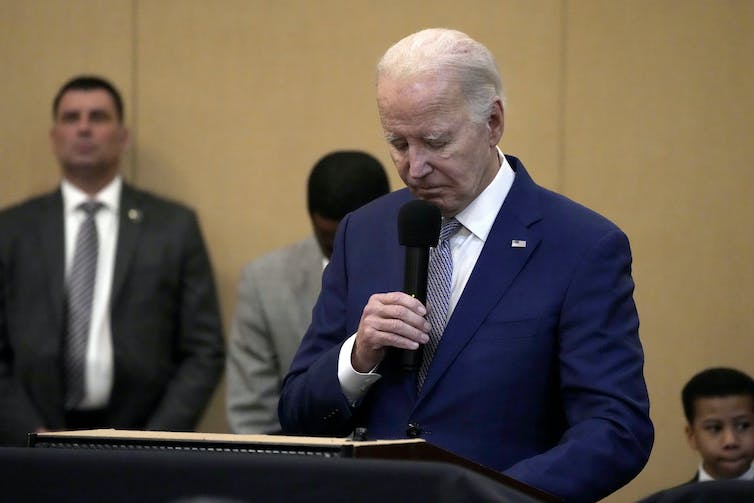A drone attack that killed three American troops and wounded at least 34 more at a base in Jordan has increased fears of a widening conflict in the Middle East – and the possibility that the U.S. may be further drawn into the fighting.
President Joe Biden vowed to respond to the assault, blaming Iran-backed militias for the first U.S. military casualties in months of such strikes in the region.
But to what extent was Iran involved? And what happens next? The Conversation turned to Sara Harmouch, an expert on asymmetric warfare and militant groups in the Middle East, to answer these and other questions.
What do we know about the group that claimed responsibility?
Al-Muqawama al-Islamiyah fi al-Iraq, which translates as the Islamic Resistance in Iraq, has claimed responsibility for the drone attack.
However, the Islamic Resistance in Iraq is not a single group per se. Rather, it is a term used to describe an umbrella organization, which, since around 2020, has included various Iran-backed militias in the region.
Initially, the Islamic Resistance in Iraq emerged as a response to foreign military presence and political interventions, especially after the 2003 U.S.-led invasion of Iraq. The Islamic Resistance in Iraq acted as a collective term for pro-Tehran Iraqi militias, allowing them to launch attacks under a single banner. Over time, it evolved to become a front for Iran-backed militias operating beyond Iraq, including those in Syria and Lebanon.
Today, the Islamic Resistance in Iraq operates as a cohesive force rather than as a singular entity – that is to say, as a network its objectives often align with Iran’s goal of preserving its influence across the region, but on a national level the groups have their distinct agendas.
The collective is notorious for its staunch anti-U.S. posture and dynamic military campaigns, such as a recent two-day drone operation targeting American forces at an Iraqi airbase.
Operating under this one banner of Islamic Resistance, these militias effectively conceal the identities of the actual perpetrators in their operations. This was seen in the deadly Jan. 28, 2024, attack on Tower 22, a U.S. military base in Jordan. Although it is evident that an Iranian-supported militia orchestrated the drone assault, pinpointing the specific faction within this broad coalition remains elusive.
This deliberate strategy hinders direct attribution and poses challenges for countries attempting to identify and retaliate against the precise culprits.
What do they hope to achieve in attacking a US target?
Iranian-backed militias have been intensifying attacks on U.S. forces in recent months in response to American support for Israel in the Israel-Hamas conflict, and also to assert regional influence.
Since the beginning of the conflict in October 2023, Iranian-backed militias have repeatedly struck American military bases in Iraq and Syria, recently expanding their attacks to include northeastern Jordan near the Syrian border.
The deadly assault on Jan. 28 marks a significant escalation, though – it is the first instance during the Israel-Hamas war that American troops have been killed.
The attack in Jordan forms part of a strategy by Iranian-backed militias to counter Washington’s support for Israel in the Gaza conflict. But it is also aimed at advancing a wider goal of pushing U.S. forces out of the Middle East entirely.
By coordinating attacks under the Islamic Resistance in Iraq, these groups are trying to display a unified stance against U.S. interests and policy, showcasing their collective strength and strategic alignment across the region.
What role did Iran have in the attack?
Iran has officially denied any involvement in the drone strike.
But the Islamic Resistance in Iraq is known to be part of the networks of militia groups that Tehran supports.
Iran, through the Islamic Revolutionary Guard Corps’ Quds Force, has provided such militias with money, weapons and training. However, the extent of Iran’s command and coordination in specific incidents like the Jordan attack remains unclear. At this stage, more concrete evidence is necessary to firmly implicate Iran.
As Iran expert Nakissa Jahanbani and I recently explained in an article for The Conversation, Iran’s strategy in the region involves supporting and funding militia groups while granting them a degree of autonomy.
By doing so, Iran maintains plausible deniability when it comes to attacks carried out by its proxies.
So while Iran’s direct involvement in the attack has not been definitively established, Tehran’s long-standing support of groups like the Islamic Resistance in Iraq is well documented, playing a significant role in the regional conflict dynamics and geopolitical strategies.
What options does the US have to respond?
It isn’t clear how the U.S. intends to respond to the attack. The Biden administration faces complex dynamics when it comes to responding to attacks linked to Iranian-backed militias.
While a forceful military strike is an option that the Biden administration appears to be looking at, targeting Iran directly on its own soil is fraught with risks and may be seen as a step too far.
AP Photo/Jacquelyn Martin
Even when targeting Iranian interests or personnel, such as the assassination of Quds Force General Qassem Soleimani, the U.S has conducted these actions outside Iranian territory.
Iran’s denial of direct involvement in the attack further complicates the situation and makes it less likely that the U.S. attacks Iran in retaliatory strikes.
But adopting a targeted approach, such as striking militia leaders outside of Iran, raises questions about the effectiveness of U.S. tactics in deterring Iran and its proxies.
This strategy has been employed in the past, yet it has not significantly curbed Iran’s or its proxies’ aggressive actions. The concern is that while such strikes are precise, they may not be enough to deter ongoing or future attacks.
The key to the strategy’s success may rest in identifying the most influential factors, or “centers of gravity,” that can effectively influence Iran’s behavior. This means determining key leaders, critical infrastructure or economic assets, which, if killed, destroyed or seized, could substantially alter Iran’s decision-making or operational capabilities.
The Biden administration’s need to balance a strong response with the geopolitical consequences highlights the difficulties of navigating a tense and evolving situation.
How might the attack affect the wider Middle East conflict?
How the U.S. responds could reshape the Middle East’s geopolitical landscape and influence the dynamics of proxy warfare in the region.
A strong military response from Washington might deter Iranian-backed militias from future attacks, but it could also provoke them into taking more aggressive actions.
In the short term, any U.S. retaliation – especially if it targets Iranian interests directly – could escalate tensions in the region.
It could also exacerbate the cycle of tit-for-tat strikes between the U.S. and Iranian-backed forces, increasing the risk of a broader regional conflict.
And given that the attack’s pretext involves the Israel-Hamas war, any U.S. response could indirectly affect the course of that conflict, impacting future diplomatic efforts and the regional balance of power.




